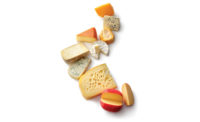Cheese has the advantage, you might say, as U.S consumers’ love affair with it continues to flourish.
Need proof? Consider that per-capita consumption of cheddar cheese increased from 9.0 pounds in 1995 to 11.2 pounds in 2018, according to data from USDA’s Economic Research Service. And per-capita consumption of mozzarella cheese climbed from 7.9 pounds in 1995 to 12.2 pounds in 2018. Although processed cheese lost ground (but regained some of it) since 1995, a similar growth story can be found among most other natural cheese types.
Milk | Cheese | Cultured | Ice Cream | Butter | Non-dairy Beverages | Ingredients | Exports
Expanded usage of cheese within foodservice has been one of the growth drivers. And with the National Restaurant Association predicting that the restaurant industry will remain healthy for the time being, cheese should continue to experience growth in that channel.
“Driven by an expanding economy and elevated consumer sentiment, the restaurant industry is expected to register positive sales growth in 2019 — growing to $863 billion in 2019,” the association says in its “2019 State of the Restaurant Industry” report.
Cheese sales continue to expand at retail, too, with data from Chicago-based market research firm IRI showing that dollar sales of natural cheese rose 1.3% during the 52 weeks ending Aug. 11, 2019, to $13,117.4 million. Unit sales climbed 2.0%.
Processed cheese struggled, however. Dollar sales fell 3.3% to $1,558.9 million, while unit sales tumbled 3.6%.
It’s Blackjack for snacking cheese
Within the retail natural cheese space, “snackability” is one of the most significant ongoing trends.
“I believe folks are seeking out convenient snackable cheeses [that do] not need to be prepared as part of a dish, including dips, and that [are] sold in an easy-to-open-and-enjoy format,” said Tomas Rizo, vice president of sales and marketing for Modesto, Calif.-based Rizo-Lopez Foods Inc. The company makes cheese under the Rizo Brothers California Creamery brand.
Ian Schuman, business unit lead, specialty cheese for Schuman Cheese, Fairfield, N.J., agreed, noting that “high-speed innovation” can be found within the cheese-snacking category.
“Producers are figuring out how to deliver great-tasting, protein-packed cheese in occasion-driven packaging,” he said. “Examples range from packaging that is portable and convenient for consumers on the go to curated trays of specialty cheeses for an instant cheese board.”
To cater to snack-loving consumers, Schuman Cheese recently debuted Cello Copper Kettle Chisels. The product consists of bite-sized pieces of Parmesan, which is crafted in copper vats to create distinctive notes of cooked caramel. According to the company, the product is designed for the health-conscious snacker, boasting 9 grams of protein and only 110 calories per serving.
And Sargento Foods Inc., Plymouth, Wis., has been particularly active during the past few years within the cheese-snacking space.
“In recent years, we found the traditional three meals a day were being replaced with and complemented by smaller and more frequent snacks,” explained Chip Schuman, senior vice president, marketing — consumer products for Sargento. “And with this shift, consumers demanded their snacks balance taste and nutrition, as well as convenience and portability to fit their busy lifestyles.”
Sargento launched its Balanced Breaks cheese snack line back in 2015, and the line ended up being the company’s most successful launch ever, Chip Schuman noted. And this year, Sargento expanded on that launch with its Sargento Sunrise Balanced Breaks. Targeting the breakfast occasion, the refrigerated snack kits combine different varieties of natural cheeses with other snackable ingredients such as vanilla blueberry quinoa clusters and blueberry juice-infused dried cranberries. They come in four varieties.
Another notable new entry into the refrigerated snack cheese kit space is the Chiquita Bites line from Fresh Express, Orlando, Fla. Offered in five varieties, the savory snack packs pair natural cheese with fresh or dried fruit; some also contain nuts, crackers or pretzels.
Outside of the snack kit space, the Borden cheese brand, licensed by Kansas City, Kan.-based Dairy Farmers of America, added habanero cheddar and extra sharp white cheddar varieties to its Borden Snack Bars line earlier this year. The individually wrapped 3/4-ounce snack bars come eight to a 6-ounce bag.
Meanwhile, the Crystal Farms brand of St. Louis-based Post Holdings targeted some of the youngest snackers with its recent launch of Nibblers and Little Nibblers on-the-go cheese snacks. The half-inch (Nibblers) and quarter-inch (Little Nibblers) cheese cubes come in single-serve packs in kid-friendly varieties: mozzarella and marble jack.
And Tillamook County Creamery Association, Tillamook, Ore., took an upscale approach to snacking with the 2019 debut of its Tillamook Cheeseboards. The products combine Tillamook cheese with crackers and artisanal fruit spreads. The company said they come in four flavor combinations: Sharp Berry Crunch, Spicy Berry Bite, Smokey Apple Crisp and Sharp Strawberry Heat.
Variety and flavor stand
Snacking isn’t the only trend playing out in the cheese segment, of course. A growing assortment of varieties also is drawing consumers in.
“New varieties are tempting the consumer’s palate,” noted Marshall Reece, senior vice president of sales and marketing for Associated Milk Producers Inc., New Ulm, Minn. “That’s prompting an expanded and varied presence of cheese at grocery stores and in restaurant meals.”
On the retail front, consumers now are able to shop for cheese in multiple locations — not just the dairy case. And restaurant dishes are featuring the new varieties, he noted.
“At the same time, social media influencers are highlighting cheese in new and inventive ways, building demand,” Reece said.
The trend toward variety fits in with the increasingly adventurous American palate, Ian Schuman said.
“It’s exciting to see so many people educating themselves about different cheese types and their history, and then embrace the chance to taste them,” he said. “Cheddar and mozzarella will always have their place, but it’s encouraging to know that we can do some experimenting as cheesemakers and importers and have such positive feedback in the market.”
For its part, Caves of Faribault, part of Edwardsville, Ill.-based Prairie Farms Dairy Inc., put a twist on familiar varieties with the recent introduction of two cave-aged cheeses: St. Helga’s European Style Swiss cheese and the Cherubic Heavenly Young Gouda. The former is crafted in a European style to achieve a complex, full-bodied flavor with pronounced nutty notes that differentiate it from traditional Swiss, while the latter exhibits a pungent, buttery flavor, the company said.
But variety-related excitement isn’t always tied to something completely new. For example, Rizo pointed out that his company is excited about introducing Hispanic flavors to a wider non-Hispanic demographic.
“We’re also looking forward to expanding into different formats such as dips and spreads,” he said.
Going hand-in-hand with the trend toward variety is the trend centering on flavors. Chip Schuman said Sargento is seeing growing interest in bold flavors — think peppers and smoked and aged formulations — for natural cheese snacks.
“People want to explore flavors and textures, and natural cheese is great for that journey,” he said.
Reece agreed, pointing to consumers’ desire for “bolder, stronger flavors” as a whole.
“The industry is responding by experimenting with different ways to age cheeses longer and by exploring new varieties of cheese for aging,” he said. “In addition, processors are continuing to climb the Scoville heat scale in their cheesemaking.”
Just how big is the cheese flavor trend? Well, Chris Hoeger, president of the Cheese Division of Edwardsville, Ill.-based Prairie Farms Dairy Inc., said a presenter at a recent seminar shared data showing that almost a quarter of new cheese products introduced in the past year —22% — were flavor variations. A flavored cheese introduction is in the pipeline for Prairie Farms, too, in the upcoming year.
“We’ll be introducing a line of flavored natural cheeses at retail that was developed by one of our own cheesemakers,” Hoeger said. “Initial market studies are very positive.”
One noteworthy flavored cheese that already made its debut this year is the Stella Fontinella 6-ounce rubbed wedge line from Saputo Cheese USA Inc., Lincolnshire, Ill. Featuring Saputo’s own Fontinella cheese, the line comes in four flavors, which are rubbed onto the cheese: Bell Pesto, Harissa, Bourbonista and Black Pepper.
And Crescent City, Calif.-headquartered Rumiano Cheese Co. recently introduced a new line called Redwood Coast. The first offering in the line, an 8-ounce block of Sriracha jack cheese, definitely is in line with the trend toward bolder, spicier flavors.
New flavors also can be found in the goat cheese space. Mariposa Dairy, Lindsay, Ontario, said it added a line of eight seasonal flavors under its Celebrity brand. Although the spring and summer flavors have come and gone, autumn flavors include Spiced Sweet Potato, Maple Toffee and Horseradish Dill. And scheduled to debut this winter are Cappuccino and Truffle cheese flavors.
Clean and sustainable say ‘hit me again’
In addition to the snacking and variety/flavor trends, there’s a trend that’s seen across almost all food and beverage categories — that toward clean labels with simple ingredients, Hoeger noted.
“Our natural cheeses typically have less than five ingredients, all non-GMO,” he added.
What’s more, eco-friendly packaging is becoming more available in compositions that fit those cleaner-label cheeses, Hoeger added.
That’s likely a good thing, as consumers are demanding more accountability, sustainability-wise, from all products, Ian Schuman said.
“I think as an industry, we have some room to do a better job of helping consumers see what kinds of eco-friendly solutions we’re applying,” he added. “We also need to continue to challenge ourselves to incorporate changes that reflect our responsibility to take care of our world and local communities, just like we have a responsibility to take care of our industry and our businesses.”
Basic strategy
Despite consumers’ love affair with cheese, cheese processors do face some challenges — now, and in the year to come. One such challenge lies in tariff- and trade-related uncertainty, which has resulted in “a disruptive environment” that hurt the industry, Ian Schuman pointed out.
“Removing the foundational constants of American business that we rely upon, like tariffs and trade deals, discourages companies from making investments and draws resources away from growth into more protective, defensive positioning,” he said. “When the preeminent question is ‘How do I protect myself from the impact of these tariffs?’ rather than ‘How do I continue to meet our core purpose?’, there’s a chilling effect — not just on businesses, but on their employees, too.”
For individual cheesemakers, another challenge is ever-shortening product development cycles, Hoeger noted.
“The award-winning specialty natural cheeses we offer typically require careful crafting, followed by a period of controlled ripening that can last as long as a year,” he explained. “So when we run trials for new products, it may take several months and iterations of trials to tune the cheese to the customer’s expectation.”
Hoeger said his company has responded to this challenge by designing trial pathways that encompass planned simultaneous variations to boost the amount of information that is generated.
“This directly correlates with another challenge that we experience, which is our responsiveness to customer wants and needs,” he said. “Cheese is a hard business. It requires time to produce quality products, and often our customers have needs with tight timelines as well. Though we battle this challenge often, we must remember to stay nimble and as responsive as we can to fulfill our customers’ needs.”
As more varieties and flavors of cheese come to market, retail shelf space also becomes an issue, Reece noted. And on the foodservice side, cheesemakers need to consider whether or not they are making it easy for chefs to access special cheeses for inclusion on their menus, as well as how they could deliver a “must-have” partner cheese for chicken sandwiches, which continue to grow in popularity.
“Currently in the U.S., 85% of burgers are served with cheese versus 15% of chicken sandwiches,” he pointed out.
Finally, there are regulatory challenges that continue. For example, FDA’s standards of identity related to dairy products, including cheese, have not been updated for decades, noted Cary Frye, senior vice president, regulatory affairs for the Washington, D.C.-based International Dairy Foods Association (IDFA).
“Petitions to change these standards to permit the use of technologies such as filtered milk as an ingredient for cheese have languished for decades,” she pointed out. “At IDFA’s urging, the FDA has recently granted regulatory discretion for cheesemakers to use ultrafiltered milk, but further changes are needed to keep pace with new technologies such as microfiltration, which can produce superior native whey proteins, along with a concentrated casein to make cheese more efficiently.”
Frye said IDFA will continue to work with its member companies to encourage the agency to allow microfiltered milk in cheesemaking while allowing processors to retain the simple word “milk” on the ingredient label.
Milk | Cheese | Cultured | Ice Cream | Butter | Non-dairy Beverages | Ingredients | Exports









